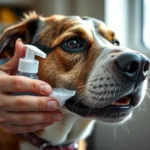
Introduction
Dog tear stains are a common concern among pet owners, particularly for those who have breeds prone to excessive tearing. These stains can appear unsightly and may lead to questions about your dog’s health and hygiene. Addressing the issue of tear stains is not merely about aesthetics; it can also be indicative of underlying health issues that require attention. In this article, we will explore the causes, prevention methods, and treatment options for dog tear stains, providing you with the information you need to keep your furry friend happy and healthy.
What Are Dog Tear Stains?
Dog tear stains are reddish-brown marks that appear on the fur around a dog’s eyes. These stains are the result of excessive tearing, where the tear fluid flows over the face and stains the fur. The stains can vary in severity, from light discoloration to deep brown patches, depending on the extent of the tearing.
Certain breeds are more prone to developing tear stains, including:
– Poodles
– Bichon Frises
– Shih Tzus
– Yorkshire Terriers
Understanding that tear stains are not just cosmetic issues is crucial; they can sometimes indicate health problems that need to be addressed.
Causes of Tear Stains
Natural Causes
Tear production in dogs is a natural and necessary process. Tears help to lubricate the eyes and flush out debris. However, some dogs produce more tears than others, which can lead to dog tear stains. Genetics and breed characteristics play significant roles in determining how much a dog tears. For example, brachycephalic breeds (those with flat faces) often have issues with tear drainage, leading to increased tearing.
Health-Related Causes
There are several health-related factors that can contribute to excessive tearing and, consequently, tear stains. Some of these include:
- Allergies: Dogs can suffer from allergic reactions to food or environmental factors, leading to increased tear production.
- Eye Infections: Conditions such as bacterial or viral infections can cause inflammation and excessive tearing.
- Conjunctivitis: Also known as pink eye, this condition can cause redness and increased tearing.
- Blocked Tear Ducts: When tear ducts become blocked, tears cannot drain properly, leading to overflow and staining.
It’s essential to consult a veterinarian if you suspect any health-related issues, as early intervention can prevent further complications.
Environmental Factors
Environmental factors can also influence the severity of dog tear stains. Key aspects include:
- Diet and Nutrition: A poor diet lacking essential nutrients can contribute to tear staining. Certain ingredients in dog food might trigger allergies.
- Water Quality: Contaminated or overly mineralized water can exacerbate tear staining.
- Grooming and Hygiene: Inadequate grooming routines can lead to the accumulation of dirt and bacteria around the eyes, increasing the likelihood of staining.
Identifying Tear Stains
Visual Inspection
Recognizing dog tear stains is typically straightforward. Look for discoloration around the eyes, which can range from light tan to deep brown. It’s essential to differentiate between normal tear staining and excessive tearing, which may require veterinary attention. If the stains are accompanied by swelling, redness, or discharge, these may be signs of a more serious issue.
When to Seek Veterinary Advice
Knowing when to seek veterinary advice is crucial. Signs indicating a need for professional evaluation include:
– Persistent or worsening tear stains
– Red or swollen eyes
– Discharge that is yellow or green in color
– Behavioral changes, such as pawing at the eyes or excessive blinking
Early detection of underlying issues can lead to more effective treatment and management.
Preventing Dog Tear Stains
Regular Grooming Practices
One of the most effective ways to prevent dog tear stains is through regular grooming. Keeping the fur around the eyes trimmed can help reduce the likelihood of staining and allows for easier cleaning. Additionally, regularly cleaning the area with a damp cloth can prevent dirt and bacteria buildup.
Dietary Considerations
Your dog’s diet plays a significant role in their overall health and appearance. Opt for high-quality dog food that contains no artificial additives or fillers. Some supplements may also help reduce tear staining, including:
– Probiotics: To promote gut health and potentially reduce allergies.
– Omega Fatty Acids: Known for their anti-inflammatory properties, these can also improve skin and coat health.
Environmental Adjustments
Making simple environmental adjustments can significantly impact tear stains. Consider using filtered or bottled water to reduce mineral intake. Additionally, opting for hypoallergenic grooming products can minimize the risk of allergic reactions that may lead to increased tearing.
Treatment Options for Dog Tear Stains
Home Remedies
If you’re looking for cost-effective solutions, there are several home remedies that can help with dog tear stains. However, caution is necessary when using these treatments. Here are a few options:
– Diluted Hydrogen Peroxide: A very mild solution can help lighten stains, but it should be used sparingly and with caution to avoid skin irritation.
– Cornstarch: Applying cornstarch can absorb moisture and help keep the area dry, reducing staining.
Always ensure to rinse the area thoroughly after using any home remedy to avoid skin irritation.
Veterinary Treatments
If home remedies do not yield results, it may be time to consult your veterinarian. They can prescribe medications to treat underlying conditions, such as allergies or infections. Additionally, some veterinarians offer professional cleaning services for tear stains, which can provide a more immediate solution.
Long-Term Management Strategies
Long-term management of dog tear stains involves ongoing monitoring and care. Establish a routine that includes regular grooming, eye cleaning, and dietary management. Keeping a close eye on any changes in your dog’s behavior or appearance can help you catch potential issues early.
FAQs about Dog Tear Stains
Are tear stains harmful?
Generally, tear stains themselves are not harmful. However, they can indicate underlying health issues that may require treatment.
Can tear stains be completely removed?
While many treatments can significantly reduce tear stains, complete removal may not always be possible, especially if the causes are genetic.
Are certain breeds more susceptible to tear stains?
Yes, breeds with short noses or prominent eyes, such as Poodles and Bichon Frises, are more likely to experience tear staining.
What products are safe to use on tear stains?
Look for products specifically designed for tear stain removal that are labeled as safe for dogs. Avoid using human products, as they may contain harmful chemicals.
Conclusion
Understanding dog tear stains is an essential part of responsible pet ownership. By recognizing the causes, implementing preventive measures, and seeking appropriate treatments, you can help your dog maintain a healthy and clean appearance. Remember, if you notice persistent issues, consulting a veterinarian is always the best course of action to ensure your furry friend remains in optimal health. Proactive care is key in managing tear stains effectively, allowing your dog to enjoy a happy, healthy life.









